IN SEARCH OF THE ALLURING: THE ART OF ZHANG PEILI
| November 28, 2011 | Post In LEAP 11
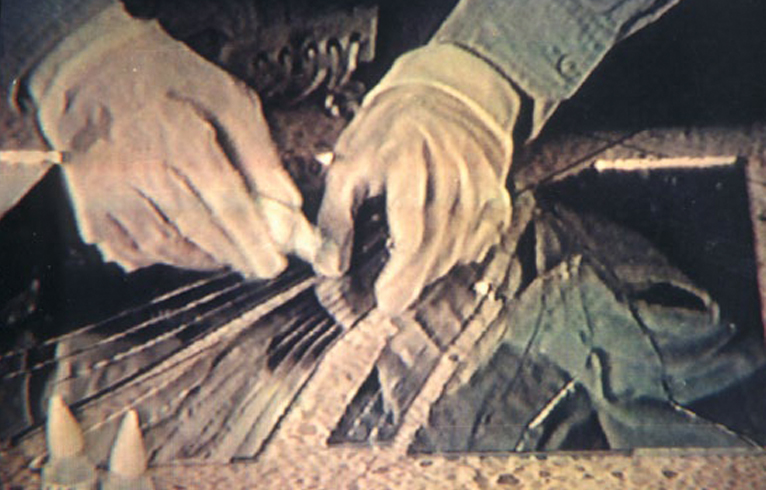
FINISHING FIRST IS a dubious honor. Zhang Peili plays down his unshakable title as the “godfather of Chinese video art” by emphasizing the contingent nature of the situation in which he won it. But the fact remains: Zhang was the first artist to bring a piece of completed video work to a high-profile gathering of artists and critics, in this case the Huangshan Conference of 1987. That conference, in turn, marked the end of the ’85 New Wave and the inception of conceptual art. This new tradition— and Zhang’s place in it— repeatedly negates the stylistic and aesthetic corruptions and discoveries of his seminal body of work itself. Constantly heralded as a categorical historical precedent, 30 x 30 (1988)— in which two gloved hands piece together, over the course of half an hour, the shards of a broken mirror— is actually a far cry from the rupture with which it is announced in the literature. Indeed, this supposed first is not merely or even primarily a medium-specific innovation in isolation, but rather is embedded within a general cultural trajectory— far from a personal narrative— that reaches back into Rational Painting as early as 1985 and leans forward into a series of installations instantiated only within the past few years, the latter made possible only as the receding tide of branded, seemingly made-for-auction painting has cleared a path for its influences and instructors.
There is a difference between the contingent production of the first work of video art and the accidental sequence of events that allowed this piece to open onto the launch of a full practice based on the exploration of this set of media techniques. It may be simply that the object at stake— the rough video 30 x 30— was alluring enough in its own right to draw its author into a play of chase and seduction that would continue for decades, placing him at the center of a vortex of connections and relationships that would both incorporate and help transition out of the dry conceptualism that preceded the violence of the late 1980s and early 1990s. That Zhang Peili is so often hailed as the founding father of video art in China has actually done a disservice to the compelling connections between his own work and the critical, artistic, and pedagogical offshoots that have come to define the field of cultural production in China today. Recent scholarship and curatorial exegesis, however, seem poised to change our understanding of both his oversized place in the canon and the considerations behind specific works.
DEBUNKING THE EXPERIMENTAL
In a retort that may one day be infamous, published in a recent catalogue, Zhang Peili rejects the proto-scientific and wholly naturalist view of praxis that marks so much of new media discourse: “an experiment with principles is not experimental at all.” In fact, he adds, it may be more experimental to do away with the framework of the experiment altogether. This acceptance of a modifier appears particularly significant positioned alongside the rejection of an exclusive label, as if it offered a potential category of analysis— albeit one that, by virtue of the limitations of its very rubric, can only be understood through but never outside of the work at hand.
Zhang Peili began to understand very early in his career that the deadpan aesthetics of boredom that he pioneered— with or without the assistance of Martha Rosler and Michael Snow, we may never know— was essentially a celebration of absurdity, or at least a strategy for the exposure of the absurd within the thin veneer of normalcy otherwise applied to the portrayal of everyday content within contemporary art. Water: Standard Version from Cihai Dictionary (1991), one of the works with which the artist may now be most closely associated given its broad exposure beyond the art world during the publicity exercises for his most recent retrospective at the Minsheng Art Museum, offers a clear view of this contrast: working through a series of acquaintances and middlemen, Zhang hired Xing Zhibin, the recently retired but once iconic CCTV newscaster, to record a segment in which she would do nothing but read a dictionary entry for the word “water.” Much has been said about the ridiculous staging of the politically charged and the trivial here, but the most lasting contribution of the project may lie instead with the sheer audacity of the project, of literally appropriating the accepted for the sake of the absurd— because this latter label does, after all, subsume the vast majority of contemporary artistic practice.
If the experimental requires an uncertainty in terms of outcome however, it might rather be Art Project No. 2 (1987) that captures the notion of the absurd experiment. Consisting of some 20 typed pages, the work details in nothing but textual instructions a game-as-exhibition in which two people engage in a highly regulated dialogue described as “talkback” or “intercommunication” while 47 others physically attack each other in an all-out (but silent) battle for peepholes positioned to monitor this activity. It is a metaphor for nothing in particular, but the brute violence of this circumscribed approach to interpersonal exchange is jarring, particularly as it remains hypothetical in the space of imagination— that is to say, closer to the reception apparatus of its audience than would otherwise be thought possible.
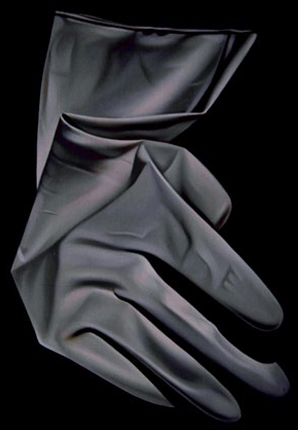
It should become clear that, even where he turns his back on principled or regulated experiments, Zhang Peili remains interested in an experimental approach to a broader idea of control. This manifests itself in two key ways: the institutionalization of the body and the instantiation of textual instructions. Where his instruction-based conceptual work was remarkably influential in the transition away from the more romantic aspects of the ’85 New Wave, the artist’s understanding of biopolitics would not become widespread until the end of the 1990s with the “Post-Sense Sensibility” era (indeed, there remains a significant unwritten chapter in the history of that decade tracing the amorphous connections of socialization, education, and influence from Zhang to Qiu Zhijie and from there to what was then the underground in northeastern Beijing). In Assignment No. 1 (1992), produced during the same time frame as Political Pop and Cynical Realism and driven by the same basic underlying impetus but worlds away in terms of expression and sensibility, 12 screens in slightly different color palettes record the distinct steps of a routine blood test, focusing on the symmetry between the finger and the glass plate as containers of blood— here not a carrier of either genetic code or some vital life force but rather a liquid pure and simple. Document on “Hygiene” No. 3 (1991), a more iconic and far more celebrated work of the same period by virtue of its straightforward single-screen arrangement and markedly absurd subject matter, finds the artist washing a chicken in a small basin over the course of a video tape, gently calming it and bringing further aspects of control to bear over its prostrate body.
By rejecting experimentation, the category of the experimental can be established as a potential property of practice rather than an end or goal. This is accomplished in part by means of erasure, a technique by which meaning is bracketed off but never completely emptied; the strategy is at work within the mobilization of absurdity, but also in more nuanced semiotic situations. In Actors’ Lines (2002), one of several works appropriating imagery from revolutionaryera films, Zhang Peili transforms what may have once been a lecture on political ideals into a vaguely homoerotic interaction subsisting on subtext alone. Although drawing on remix culture in a rather conservative way, the editing focuses on locating meaning sublimated within the original text of the film by placing its context under erasure entirely, allowing for an experimental space with no expected outcome and no beginning or end to experimentation.
EMBRACING THE CRITICAL
Just as it denies the capacity of the experiment in favor of facets of the experimental, Zhang Peili’s understanding of the role of art, in its intense uncertainty, forgoes the possibility of critique for the label of criticality on a more general model. Here, specificity is often transferred from the object of criticism to the apparatus of the invocation of the critical. In Eating (1997) three stacked monitors track as many aspects of the basic situation of the titular actions: on the top the viewer sees an extreme close-up of a chewing jaw, in the middle a camera attached to a fork spins wildly from mouth to plate, and on the bottom pieces of food slowly disappear as the meal continues. By focusing on a highly particular and bounded scope of object and event— in this case, the simple act of eating— the specificity of any criticism the work wishes to launch is dissipated, exploded, and made universal. A similar set of tactics is applied to Procedure of “Ask First, Shoot Later”: About “X?” (1987), another landmark text piece tied up with the production of the extensive series of paintings called “X?” (1986-1987) in which the artist lays out violently constrained restrictions for viewing ranging from the maximum and minimum height of the audience to the length of time each viewer may (or must) examine each painting, not to mention the spatial layout of the hundred-plus works in small cubicles. Again, it is by collapsing the conceptual space around the work that the artist manages to butcher critique while coating its content— be it text or the paintings themselves— with a thick sense of the critical.
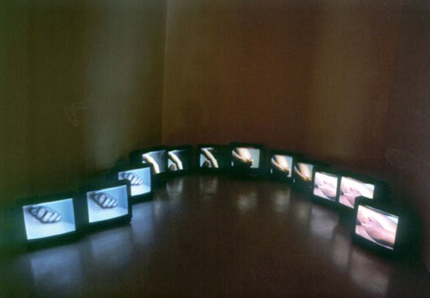
This sense of diffuse criticality also comes from more expected sources. In works like Happiness (2006) there is something of the bracketing or erasure that Zhang Peili employs as a component of his experimental explorations, but there is also a less defined tendency toward negativity that generally gives way, in the viewer, to a perception of critical production that may not have been present in the original editing. For this particular project the artist again appropriates film footage from the 1975 revolutionary picture In the Shipyard, splitting onto two screens a scene in which one character delivers a rousing speech of incitement and, facing this first screen but playing only when it pauses, a crowd swept up in raucous and emotional applause. Focusing on the specific reaction of clapping while breaking the scene down into a primal relationship of production and reception, a sense of the automatic rejection of whatever positive emotion of information is conveyed becomes a natural next step.
Many of Zhang Peili’s newer installations hinge on an outrageous scale that is often critiqued as overblown. In fact, these outsized scenarios are in essence no different from earlier projects which remained unrealized, conceptual texts. But now endowed with the conditions to make his visions real, Zhang turns to scale and immediacy as a tool for the production and shaping of affect. Although the moving image is, without a doubt, the most effective tool for guiding reception in this way, it is also massively overdetermined— with skill, a decent editor can predict and guide typical viewer reactions to any set of video clips. With projects like the recent A Necessary Cube (2011), then, the artist seeks a much more general and less easily interpreted gut reaction: a silver fabric lies flaccid on the floor in a dark room, then suddenly begins to fill with air and, as it inflates, pushes any viewers present further and further back towards the doorway; as it stretches taut and the danger of it popping or reaching all the way to the far wall becomes tangible, it deflates and recedes just as suddenly. In this case Zhang is interested in the deferral of meaning and suspension of judgment, creating a system for pure affect that essentially primes the viewer for the more concrete, specific, and subtle work of the moving image; the massive silver sac is ultimately a blank screen, but it is its blankness rather than its screen-ness that brings it into being.
PURSUING THE ALLURING
Above and against the constant characterization of Zhang Peili’s work as experimental and critical, I would like to propose a third way of reading this body of work, in terms of its allure. Drawing on the object-oriented aesthetics of Graham Harman, for whom allure marks the “separation from an object and its qualities” by temporarily and partially decomposing the ties between the wholeness of the object and its perceived distinct qualities, there is a certain sense in Zhang’s work through which the properties of its production— including certainly and perhaps most importantly the critical and experimental, as well as the specificity of its media— dissolve, melted into the central object of the work that is suddenly if slightly withdrawn from its relational context.
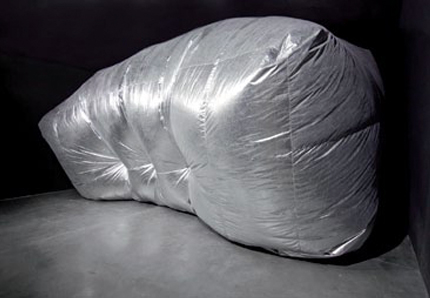
This is accomplished, at least in part, through indeterminacy. In Live Report: Hard Evidence No. 1 (2009), the burnt-out body of a small van sits on a low plinth, its mechanical corpse installed with some 60 pinhead cameras and overshadowed with a massive projection on the wall fed by the video streams of these hidden (indeed, mostly invisible) surveillance instruments. The image on the wall changes by the second from one video source to another, at times showing a viewer walking around or peering into the car but at times showing only black or a blank wall. All rhetoric of media convention aside, the work defines itself as an object by immediately making all of its relations contingent and indeterminate: no camera or image marks a component of a narrative or even a system, instead existing only as a brief fragment that contributes to the constantly altered definition of the object at hand. In this analysis instability is a key property of allure, destabilizing the properties of the object— the contingent images that relate it to its audience and environment— in favor of an object in motion.
That affect plays no small role in allure should be obvious, a phenomenon best represented in Uncertain Pleasure (1996). Here, as a hand scratches different parts of a body in extreme close-up on 12 screens strewn across an area of the floor, Zhang Peili not only constructs an object able to produce pools of allure alongside eddies of affect but also brings the notion of allure into the work itself: each image is independent and unconnected to any other segment, but the intensity of the piece is greatly magnified by the continuous reproduction of gesture on the scale of some dozen manifestations. It is a raw and itchy mess of affect that draws together work and viewer here, but a violent and altogether less pleasurable sense of fear can also be productive. In the early project Brown Book No. 1 (1988) the artist engaged in an altogether more threatening version of mail art by sending latex gloves and fragments thereof with cryptic letters of explanation to art students chosen at random from a campus register, an exercise in interpellation that forced its subjects to understand themselves through the label of “the recipient,” instructed never to ask where the objects came from. This is a recurring strategy for Zhang, and could be said to occur in more recent work like A Necessary Cube and Live Report as well: forcible affect draws the viewer into an ever more contingent, accidental, and ill-defined relationship with an uncanny object.
In the final analysis, it is always the object itself that reinscribes this force of attraction. Bringing us full circle back to that mythical first video piece, 30 x 30, we find that, no matter how experimental the format of the work or how critical the on-screen action in which the artist breaks and then slowly repairs a small piece of mirror roughly the size of a television screen, it is actually the object of the mirror in which there forms a cavity of allure. As the face of the artist flickers over its surface, the mirror reproduces itself as the glass screen of the video monitor on which the work plays, creating something of a wormhole through time that transforms the video into sculpture and back again into a disembodied moving image, a queer process that draws the viewer endlessly back inside. Something similar occurs with “X?,” the series of primarily black and white paintings of latex gloves and dentist chairs. Despite the formally experimental and socially critical conceptual framework within which the work places itself, the paintings remain virulently alluring through a distinct set of properties, simultaneously absorbing these aspects of their relations while sublimating them into the oddly fascinating image of the glove itself. These are bizarre pictures that speak strangely and out of turn.
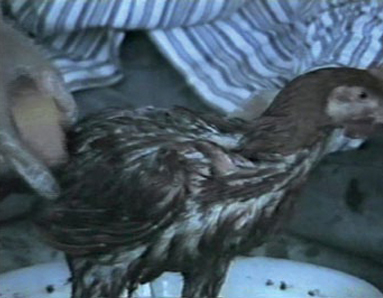
As such, it may be that the time is right for Zhang Peili’s contributions to artistic practice and pedagogy, particularly in electronic media but also more generally in experimental art, to migrate from the category of simple historical disruptions— his long list of “firsts”— to stylistic and even ontological interventions in viewing practices. Rather than seeing Zhang’s work in text as the purest instantiation of the turn toward the linguistic and conceptual in the period of 1987-1989, it may be more interesting to ask what he offers for conceptual art writ large, inside or outside of the Chinese milieu. If the properties of allure are to be believed, we might note, in the transition from Rational Painting to textual instructions (including for the production of paintings belonging also to the former category), the painterly quality of the conceptual; the conceptual or generative production of painting, of course, is common, but the reversal into the painterly composition of concept— because indeed the painting preceded the instruction— is a step of great consequence. Similarly, Zhang situates this painterly conceptual work within a social situation defined by viewing restrictions and biopolitical control, a rubric that would later expand to cover much of his work in video. Rather than evacuating conceptual art of any political content, here it becomes an unavoidable portion of the contextual fabric.
In another way, contributions to lens-based media are not limited to the retrospective historical race for the first piece of video art or the broadening of tentative explorations in interactive installation. Nor, indeed, would it be entirely correct to surmise that the value of Zhang Peili’s video lies largely with his translation of the artistic medium into a distinct media ecology, bringing consumer-grade recording technology into contact with a nascent culture of domestic television viewing at a time in which not only video but also the channels of distribution differed markedly from the political and technical situation of the American and German contexts within which video art first emerged. Instead, I propose viewing the object-centered moving image compositions (among other works including earlier paintings and recent installations) as highly successful attempts to produce the affect of allure: ignoring the perspectival viewing conditions of still-image media translated into a standard human-centered relationship of subject to (mediated) object that characterize the Western video art that would have influenced Zhang Peili, here the chicken, the mirror, and the glove speak in uncanny ways never before imagined.

